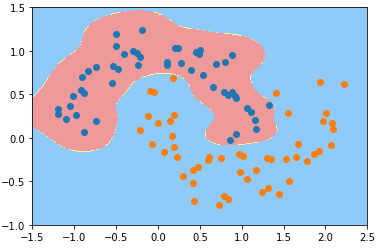机器学习:SVM(scikit-learn 中的 RBF、RBF 中的超参数 γ)
一、高斯核函数、高斯函数

- μ:期望值,均值,样本平均数;(决定告诉函数中心轴的位置:x = μ)
- σ2:方差;(度量随机样本和平均值之间的偏离程度:
 ,
, 为总体方差,
为总体方差,  为变量,
为变量,  为总体均值,
为总体均值,  为总体例数)
为总体例数)
- 实际工作中,总体均数难以得到时,应用样本统计量代替总体参数,经校正后,样本方差计算公式:S^2= ∑(X-
 ) ^2 / (n-1),S^2为样本方差,X为变量,
) ^2 / (n-1),S^2为样本方差,X为变量,  为样本均值,n为样本例数。
为样本均值,n为样本例数。
- σ:标准差;(反应样本数据分布的情况:σ 越小高斯分布越窄,样本分布越集中;σ 越大高斯分布越宽,样本分布越分散)
- γ = 1 / (2σ2):γ 越大高斯分布越窄,样本分布越集中;γ 越小高斯分布越宽,样本分布越密集;
二、scikit-learn 中的 RBF 核
1)格式
-
from sklearn.svm import SVC svc = SVC(kernel='rbf', gamma=1.0)
# 直接设定参数 γ = 1.0;
2)模拟数据集、导入绘图函数、设计管道
- 此处不做考察泛化能力,只查看对训练数据集的分类的决策边界,不需要进行 train_test_split;
-
模拟数据集
import numpy as np import matplotlib.pyplot as plt from sklearn import datasets X, y = datasets.make_moons(noise=0.15, random_state=666) plt.scatter(X[y==0, 0], X[y==0, 1]) plt.scatter(X[y==1, 0], X[y==1, 1]) plt.show()

-
导入绘图函数
def plot_decision_boundary(model, axis): x0, x1 = np.meshgrid( np.linspace(axis[0], axis[1], int((axis[1]-axis[0])*100)).reshape(-1,1), np.linspace(axis[2], axis[3], int((axis[3]-axis[2])*100)).reshape(-1,1) ) X_new = np.c_[x0.ravel(), x1.ravel()] y_predict = model.predict(X_new) zz = y_predict.reshape(x0.shape) from matplotlib.colors import ListedColormap custom_cmap = ListedColormap(['#EF9A9A','#FFF59D','#90CAF9']) plt.contourf(x0, x1, zz, linewidth=5, cmap=custom_cmap)
-
设计管道
from sklearn.preprocessing import StandardScaler from sklearn.svm import SVC from sklearn.pipeline import Pipeline def RBFKernelSVC(gamma=1.0): return Pipeline([ ('std_scaler', StandardScaler()), ('svc', SVC(kernel='rbf', gamma=gamma)) ])
3)调整参数 γ,得到不同的决策边界
- γ == 0.1
svc_gamma_01 = RBFKernelSVC(gamma=0.1) svc_gamma_01.fit(X, y) plot_decision_boundary(svc_gamma_01, axis=[-1.5, 2.5, -1.0, 1.5]) plt.scatter(X[y==0, 0], X[y==0, 1]) plt.scatter(X[y==1, 0], X[y==1, 1]) plt.show()

-
γ == 0.5
svc_gamma_05 = RBFKernelSVC(gamma=0.5) svc_gamma_05.fit(X, y) plot_decision_boundary(svc_gamma_05, axis=[-1.5, 2.5, -1.0, 1.5]) plt.scatter(X[y==0, 0], X[y==0, 1]) plt.scatter(X[y==1, 0], X[y==1, 1]) plt.show()

-
γ == 1
svc_gamma_1 = RBFKernelSVC(gamma=1.0) svc_gamma_1.fit(X, y) plot_decision_boundary(svc_gamma_1, axis=[-1.5, 2.5, -1.0, 1.5]) plt.scatter(X[y==0, 0], X[y==0, 1]) plt.scatter(X[y==1, 0], X[y==1, 1]) plt.show()

-
γ == 10
svc_gamma_10 = RBFKernelSVC(gamma=10) svc_gamma_10.fit(X, y) plot_decision_boundary(svc_gamma_10, axis=[-1.5, 2.5, -1.0, 1.5]) plt.scatter(X[y==0, 0], X[y==0, 1]) plt.scatter(X[y==1, 0], X[y==1, 1]) plt.show()

-
γ == 100
svc_gamma_100 = RBFKernelSVC(gamma=100) svc_gamma_100.fit(X, y) plot_decision_boundary(svc_gamma_100, axis=[-1.5, 2.5, -1.0, 1.5]) plt.scatter(X[y==0, 0], X[y==0, 1]) plt.scatter(X[y==1, 0], X[y==1, 1]) plt.show()

4)分析
- 随着参数 γ 从小到大变化,模型经历:欠拟合——优——欠拟合;
- γ == 100 时:
- 现象:每一个蓝色的样本周围都形成了一个“钟形”的图案,蓝色的样本点是“钟形”图案的顶部;
- 原因:γ 的取值过大,样本分布形成的“钟形”图案比较窄,模型过拟合;
- 决策边界几何意义:只有在“钟形”图案内分布的样本,才被判定为蓝色类型;否则都判定为黄山类型;
- γ == 10 时,γ 值减小,样本分布规律的“钟形”图案变宽,不同样本的“钟形”图案区域交叉一起,形成蓝色类型的样本的分布区域;
- 超参数 γ 值越小模型复杂度越低,γ 值越大模型复杂度越高;
分类:
机器学习算法





· 10年+ .NET Coder 心语,封装的思维:从隐藏、稳定开始理解其本质意义
· .NET Core 中如何实现缓存的预热?
· 从 HTTP 原因短语缺失研究 HTTP/2 和 HTTP/3 的设计差异
· AI与.NET技术实操系列:向量存储与相似性搜索在 .NET 中的实现
· 基于Microsoft.Extensions.AI核心库实现RAG应用
· 阿里巴巴 QwQ-32B真的超越了 DeepSeek R-1吗?
· 10年+ .NET Coder 心语 ── 封装的思维:从隐藏、稳定开始理解其本质意义
· 【译】Visual Studio 中新的强大生产力特性
· 【设计模式】告别冗长if-else语句:使用策略模式优化代码结构
· 字符编码:从基础到乱码解决